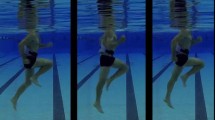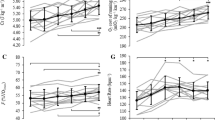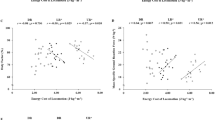Abstract
The purpose of this study was to analyze the cardiorespiratory, neuromuscular and kinematic responses obtained during the stationary running in aquatic and dry land environments. Twelve women took part in the experimental protocol. Stationary running was performed for 4 min at three submaximal cadences and for 15 s at maximal velocity, with the collection of kinematic (peak hip angular velocity (AV)), cardiorespiratory (oxygen uptake (VO2)) and neuromuscular variables (electromyographic (EMG) signal from the rectus femoris (RF), vastus lateralis (VL), semitendinosus (ST) and short head of the biceps femoris (BF) muscles) in land-based and water-based test protocols. Factorial ANOVA was used, with an alpha level of 0.05. AV was significantly higher when the exercise was performed on land, and became significantly higher as the execution cadence increased. Similarly, VO2 was significantly higher in the land-based exercise and rose as cadence increased. With the increase in the submaximal execution cadences, there was no corresponding increase in the EMG signal from the VL, BF, RF and ST muscles in either environment, though such a significantly increase was seen between the submaximal cadences and the maximal velocity. Dry land presented significantly greater EMG signal responses for all muscles at the submaximal cadences, except for the ST muscle. However, at the maximal velocity, all the analyzed muscle groups showed similar responses in both environments. In summary, for both environments, cardiorespiratory responses can be maximized by increasing the submaximal cadences, while neuromuscular responses are only optimized by using maximal velocity.





Similar content being viewed by others
References
Alberton CL, Coertjens M, Figueiredo PAP, Kruel LFM (2005) Behavior of oxygen uptake in water exercises performed at different cadences in and out of water. Med Sci Sports Exerc 37(5):S103
Alberton CL, Olkoski MM, Becker ME, Pinto SS, Kruel LFM (2007a) Cardiorespiratory responses of post-menopause women to different hydrogymnastic exercises. Int J Aquat Res Educ 1:363–372
Alberton CL, Silva EM, Tartaruga MP, Cadore EL, Becker ME, Brentano MA, Kruel LFM (2007b) Electromiographic signal reliability analysis during isometric and dynamic actions performed in different environments. Rev Bras Biomec 8:81–88 (In Portuguese)
Alberton CL, Silva EM, Cadore EL, Coertjens M, Beyer PO, Marocco LF, Kruel LFM (2008) Electromyographic responses induced by superficial electrodes isolation and by immersion. Rev Port Cienc Desp 8(3):330–336 (In Portuguese)
Alberton CL, Tartaruga MP, Pinto SS, Cadore EL, Silva EM, Kruel LFM (2009) Cardiorespiratory responses to stationary running at different cadences in water and on land. J Sports Med Phys Fit 49:142–151
Alexander R (1977) Mechanics and energetic of animal locomotion. In: Alexander R, Goldspink G (eds) Swimming. Chapman & Hall, London, pp 222–248
Black GL, Müller E, Tartaruga MP, Brentano MA, Figueiredo PAP, Kruel LFM (2006) Electromyography in aquatic exercise with different resistances and velocities. In: Vilas-Boas JP, Alves F, Marques AS (eds) Xth international symposium biomechanics and medicine in swimming. Port J Sport Sci 6(Suppl. 1):75
Carvalho RGS, Amorim CF, Perácio LHR, Coelho HF, Vieira AC, Karl Menzel HJ, Szmuchrowski LA (2010) Analysis of various conditions in order to measure electromyography of isometric contractions in water and on air. J Electromyogr Kinesiol 20:988–993. doi:10.1016/j.jelekin.2009.12.002
Cassady SL, Nielsen DH (1992) Cardiorespiratory responses of healthy subjects to calisthenics performed on land versus in water. Phys Ther 75:532–5382
Cooke CB (1996) Metabolic rate and energy balance. In: Eston R, Reilly T (eds) Kinanthropometry and exercise physiology laboratory manual. E & FN Spon, London, pp 175–195
DeLuca CJ (1997) The use of surface electromyography in biomechanics. J Appl Biomec 13:135–163
Figueiredo PAP, Borges NG Jr, Tartaruga LAP, Kruel LFM (2006) Methodology of isolate the system to collect EMG signal in the water. Aquat Fit Res J 3(1):32
Hall J, McDonald IA, Maddison PJ, O’Hare JP (1998) Cardiorespiratory responses to underwater treadmill walking in healthy females. Eur J Appl Physiol 77:278–284
Harrisson RA, Hillman M, Bulstrode S (1992) Loading of the lower limb when walking partially immersed: implications for clinical practice. Physiotherapy 78:164–166
Heithold K, Glass SC (2002) Variations in the heart rate and perception of effort during land and water aerobics in older women. J Exerc Physiol 5(4):22–28
Hof AL, Elzinga H, Grimmius W, Halbertsma JPK (2002) Speed dependence of averaged EMG profiles in walking. Gait Posture 16:78–86
Howley ET, Basset DR Jr, Welch HG (1995) Criteria for maximal oxygen uptake: review and commentary. Med Sci Sports Exerc 27:1292–1301
Hug F, Decherchi P, Narqueste T, Jammes Y (2004) EMG versus oxygen uptake during cycling exercise in trained and untrained subjects. J Electromyogr Kinesiol 14:187–195
Kaneda K, Sato D, Wakabayashi H, Nomura T (2009) EMG activity of hip and trunk muscles during deep-water running. J Electromyogr Kinesiol 19:1064–1070
Kelly BT, Roskin LA, Kirkendall DT, Speer KP (2000) Shoulder muscle activation during aquatic and dry land exercises in nonimpaired subjects. J Orthop Sports Phys Ther 30(4):204–210
King GA, McLaughlin JE, Howley ET, Basset DR Jr, Ainsworth BE (1999) Validation of Aerosport KB1-C portable metabolic system. Int J Sports Med 20:304–308
Knutson LM, Soderberg GL, Ballantyne BT, Clarke WR (1994) A study of various normalization procedures for within day electromyographic data. J Electromyogr Kinesiol 4(1):47–59
Kruel LFM (1994) Hydrostatic weight and heart rate in subjects immersed at different water depths. Unpublished master dissertation. Santa Maria. Federal University of Santa Maria, Brazil (In Portuguese)
Kruel LFM (2000) Physiological and biomechanical alterations in individuals practicing water exercises inside and outside of the water. Unpublished doctoral thesis. Santa Maria. Federal University of Santa Maria, Brazil (In Portuguese)
Kruel LFM, Tartaruga LAP, Tartaruga MP, Larronda ACC, Loss JF (2002) Kinematic analysis of middle-distance runners during treadmill running in deep water running. In: XX International symposium on biomechanics in sports. Cáceres, Spain, pp 88–91
Masumoto K, Takasugi S, Hotta N, Fujishima K, Iwamoto Y (2004) Electromyographic analysis of walking in water in healthy humans. J Physiol Anthropol Appl Human Sci 23(4):119–127
Masumoto K, Tomoki S, Hotta N, Fujishima K (2008) Muscle activation, cardiorespiratory response, and rating of perceived exertion in older subjects while walking in water and on dry land. J Electromyogr Kinesiol 18(4):581–590
Masumoto K, Delion D, Mercer JA (2009) Insight into muscle activity during deep water running. Med Sci Sports Exerc 41(10):1958–1964
McIntosh BR, Neptune RR, Horton JF (2000) Cadence, power, and muscle activation in cycle ergometry. Med Sci Sports Exerc 32(7):1281–1287
Miyoshi T, Shirota T, Yamamoto S, Nakazawa K, Akai M (2004) Effect of the walking speed to the lower limb joint angular displacements, joint moments and ground reaction forces during walking in water. Disabil Rehabil 26(12):724–732
Miyoshi T, Nakazawa K, Tanizaki M, Sato T, Akai M (2006) Altered activation pattern in synergistic ankle plantarflexor muscles in a reduced-gravity environment. Gait Posture 24:94–99
Müller ESM, Black GL, Figueiredo PAP, Kruel LFM, Hanish C, Appel HJ (2005) Electromyographic comparison of abdominal exercises in and out of water. Rev Port Cienc Desp 5(3):255–265 (In Portuguese)
Pinto SS, Liedtke GV, Alberton CL, da Silva EM, Cadore EL, Kruel LFM (2010) Electromyographic signal and force comparisons during maximal voluntary isometric contraction in water and on dry land. Eur J Appl Physiol 110:1075–1082. doi:10.1007/s00421-010-1598-0
Rainoldi A, Cescon C, Bottin A, Casale R, Caruso I (2004) Surface EMG alterations induced by underwater recording. J Electromyogr Kinesiol 14:325–331
Shono T, Fujishima K, Hotta N, Ogaki T, Ueda T, Otoki K, Teramoto K, Shimizu T (2000) Physiological responses and RPE during underwater treadmill walking in women of middle and advanced age. J Physiol Anthropol Appl Human Sci 19(4):195–200
Shono T, Masumoto K, Fujishima K, Hotta N, Ogaki T, Adachi T (2007) Gait patterns and muscle activity in the lower extremities of elderly women during underwater treadmill walking against water flow. J Physiol Anthropol 26(6):579–586
Acknowledgments
This study was supported by CAPES and CNPq. The authors wish to thank MIOTEC and INBRAMED companies for their invaluable contribution to this study.
Conflict of interest
We wish to confirm that there are no known conflicts of interest associated with this publication and there has been no significant financial support for this work that could have influenced its outcome.
Author information
Authors and Affiliations
Corresponding author
Additional information
Communicated by Toshio Moritani.
Rights and permissions
About this article
Cite this article
Alberton, C.L., Cadore, E.L., Pinto, S.S. et al. Cardiorespiratory, neuromuscular and kinematic responses to stationary running performed in water and on dry land. Eur J Appl Physiol 111, 1157–1166 (2011). https://doi.org/10.1007/s00421-010-1747-5
Accepted:
Published:
Issue Date:
DOI: https://doi.org/10.1007/s00421-010-1747-5




